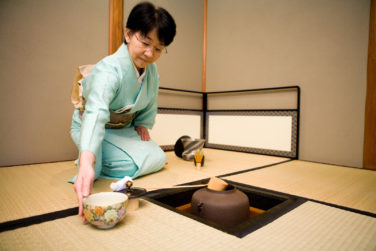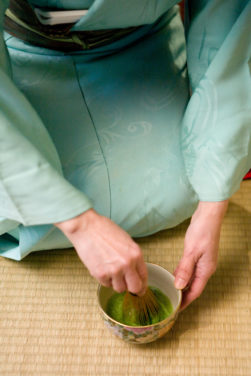This article was originally featured in the April 2016 issue of The Garden Path magazine.
 We are honored to partner with Kashintei Kai who generously donate their time and knowledge to share the ancient and beautiful garden art form of Chado, the Way of Tea with our members and visitors.
We are honored to partner with Kashintei Kai who generously donate their time and knowledge to share the ancient and beautiful garden art form of Chado, the Way of Tea with our members and visitors.
While these demonstrations can seem quiet and foreign to an American audience, an understanding of the steps and intentions helps the viewer appreciate what they are seeing. What are we meant to observe when watching such a special demonstration?
The Way of Tea is intrinsically linked to Japanese gardens and understanding the kokoro (heart) of Japanese gardening. As such an important component, we want to delve into helping our readers understand the complexities of Chado and what makes it such an inspiring practice.
The excerpt below is the first in a new multipart series on tea in which we begin to examine and explain The Way of Tea. We hope you enjoy it.
THE WAY OF TEA: SETTING THE ATMOSPHERE

The room is ten square feet of woven tatami mats. Everything has been carefully handmade of natural materials—clay, straw, and sand; bamboo, wood, and iron. Nothing inside distracts from its function as a quiet space to spend a meditative moment. Removed for an hour or two from the chaos of everyday life, one can focus completely on this shared moment as if it were once in a lifetime: Ichigo, ichie.
The sparseness of the room directs attention to each object within it. A single flower tossed in a rustic bamboo vase curves gracefully as if it were still in the forest. A sturdy clay tea bowl with a rough texture and mottled colors feels comfortingly imperfect in one’s hands. There is the sound of water simmering in a rustic tea kettle, the fragrance of hot charcoal. The air is not “conditioned”—just warm enough not to shiver, and cool enough to relax. No more, no less.
Having prepared tea a thousand times in the same careful manger, the host flows through the motions unselfconsciously and with considerable grace. He is the essence of calm hospitality, focused solely on his guests’ comfort and enjoyment. The guests are attentive, waiting for just the right moment to remark that the scroll hanging in the alcove sets just the right tone for the day. “Sincerity” it reads, nothing more.
—Diane Durston, from Wabi Sabi: The Art of Everyday Life